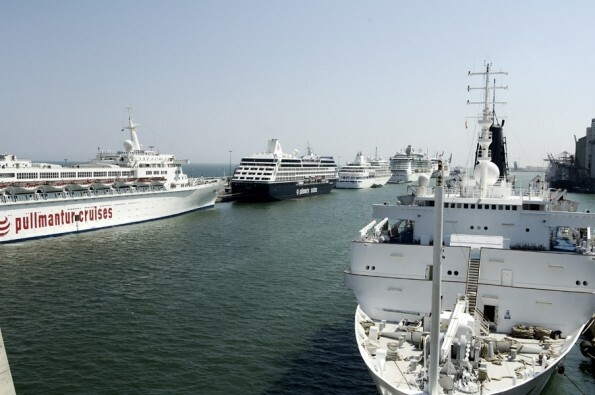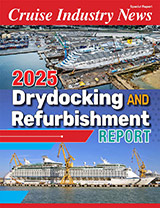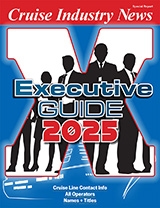 One of the biggest issues facing the European market is the environment. As the climate-change debate heats up, more industries are under pressure to reduce harmful emissions, and the cruise industry is no exception.
One of the biggest issues facing the European market is the environment. As the climate-change debate heats up, more industries are under pressure to reduce harmful emissions, and the cruise industry is no exception.
MedCruise is focusing heavily on environmental issues, said President Laurent Monsaingeon, who is also director of French Riviera Ports; and Bill Gibbons, director of the UK-based Passenger Shipping Association (PSA) and director of marketing for the European Cruise Council, said efforts are underway to set up a sustainable-environment committee at the PSA and Council level.
“I’m sure that on the next board of directors of MedCruise there will be one person dedicated to the issue,” Monsaingeon said.
Iain Dunderdale, chairman of Cruise Europe’s UK and Ireland section and cruise development manager at Port of Ivergordon, said it looks as though the EU might well pass legislation to reduce sulfur and carbon dioxide emissions, as well as the amount of particulate matter.
“Environmental issues are the biggest buzzword in the industry right now, so we definitely have to address that much more specifically than we’ve done `so far,” said Bo Larsen, director of Cruise Baltic.
Regulations
“We think that the regulatory answer is a good solution whether it is through limitations or taxes,” said Monsaingeon.
However individual countries’ handing down their own mandates would make for choppy seas. Constantly changing local or regional rules on fuel emissions and the like just make operations a guessing game.
Europe is more of a regulatory culture, and “sometimes not very efficient,” Monsaingeon said. “Some of our ports are not able to say no but are not able to say yes. So they will wait for the last minute, and sometimes the cruise lines and ships will be very disappointed.”
Norway’s NOX tax is so far the only such tax passed by an individual country, but it unleashed trepidation in the industry that other countries would follow suit, each creating their own conditions and criteria and forcing ships to change their operating methods every time they cross a border.
Congestion
Cruise Europe Chairman Dirk Moldenhauer said cruise lines need to expand beyond the Mediterranean and the Baltic, and explore ports in Northern and Western Europe
“They’re like the lemming, all of them in the Baltic,” said Moldenhauer, who is also chairman of the Atlantic Alliance and general manger at the Hamburg Cruise Center. “Spread out, use more than Norway and Iceland and more of Western Europe ports. They have so much to offer.”
“There will be one day when they wake up and say, hey, it’s like the Caribbean; it’s overcrowded,” he said.
Monsaingeon said, in the Mediterranean, cruise lines need to coordinate calls to ameliorate congestion.
Congestion puts ports in the awkward position of either rationing arrivals themselves or being overrun, displeasing both passengers and residents, he said.
Security
It all involves getting everyone in line, said Albert Poggio, senior vice president of MedCruise and marketing director at the Port of Gibraltar. When it comes to security, EU members all conform to the relevant regulations. But there are ports in the Mediterranean that don’t belong to the EU and for a time did not necessarily see or agree on the importance of meeting EU security standards.
“So we had to put a lot of effort into convincing these countries to adopt the EU’s regulations so they’d all be uniform,” Poggio said. “What we call the Med circuit and all its ports now really conform to all requests laid down by the EU and the American Coast Guard.”
Public Perception
Public perception can be tricky. Monsaingeon recounted the irony of a recent visit by P&O’s Ventura, a state-of-the-art ship, on its maiden voyage. Ville France was its second call. The city’s officials came onboard.
“All these people had questions about the environmental equipment of the Ventura – which is brand-new, top-class, superb equipment – 500 percent more than any city in terms of garbage disposal, processing – they are perfect onboard the ship. And yet we had questions from one of the deputy mayors who has a degree in biology,” said Monsaingeon.
“And this was in a city where they don’t even have wastewater processing, which is against any French regulation,” he said. “And yet the deputy mayor was requiring explanations even though their very own city is not compliant with the (environmental) regulations.”
Here to Stay
Challenges or not, the cruise industry is firmly planted in Europe. “We are focused on our industry, and the governments and the European parliaments are turning their attention to us,” Poggio said. “We’re on the radar screen, and that can only be good for the industry as a whole.”
Gibbons said the European cruise industry is carrying about 4 million passengers annually as opposed to 10 million Americans who cruise, even though the populations are about the same. “So the potential in Europe is absolutely huge in terms of a source market for visiting cruise ships.
Excerpted from Cruise Industry News Quarterly Magazine: Summer 2008



